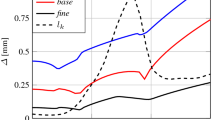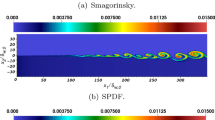Abstract
A unified second-order moment (USM) turbulence-chemistry model for simulating NOx formation in turbulent combustion is proposed. All of correlations, including the correlation of the reaction-rate coefficient fluctuation with the concentration fluctuation, are closed by the transport equations in the same form. This model discards the approximation of series expansion of the exponential function or the approximation of using the product of several 1-D PDF's instead of a joint PDF. It is much simpler than other refined models, such as the PDF transport equation model and the conditional moment closure model. The proposed model is used to simulate methane-air swirling turbulent combustion and NOx formation. The prediction results are in good agreement with the experimental results.
Similar content being viewed by others
References
Tanahashi M, Yu Y, Miyauchi T. Effects of turbulence intensity on the structure of hydrogen-air turbulent premixed flame. In: Nagano Y ed. Proc 3rd Inter Symp on Turbulence, Heat and Mass Transfer, Nagoya, 2000-4-2-6, Nagoya: Aichi Shuppan, 2000. 823–830
Park N, Kobayashi T, Taniguchi N. Application of flame wrinkling LES combustion models to a turbulent premixed combustion around bluff body. In: Nagano Y ed. Proc 3rd Inter Symp on Turbulence, Heat and Mass Transfer, Nagoya, 2000-4-2-6, Nagoya: Aichi Shuppan, 2000, 847–854
Pope SB. PDF methods for turbulent reactive flows.Prog Energy Combust Sci, 1985, 11: 119–192
Bilger RW. Conditional moment closure for turbulent reacting flows.Physics of Fluids, 1993, A5: 436–473
Zhou LX. Theory and Numerical Modeling of Turbulent Gas-Particle Flows and Combustion. Beijing: Science Press and Florida: CRC Press, 1993
Zhou LX. Advances in numerical modeling of turbulent reaction rate of NOx formation.Advances in Mechanics, 2000, 30:77–82 (in Chinese)
Liao CM, Liu Z, Liu C. NOx prediction in 3-D turbulent diffusion flames by using implicit multigrid methods.Combustion Science and Technology, 1996, 119: 219–260
Zhou X, Sun Z, Brenner G, Durst F. Combustion modeling of turbulent jet diffusion hydrogen/air flame with detailed chemistry.Int J Heat and Mass Transfer, 2000, 43: 2075–2088
Chen XL, Zhou LX, Zhang J. Numerical simulation of methane-air turbulent jet flame using a new secondorder moment model.Acta Mechanica Sinica, 2000, 16: 41–47
Zhou LX, Chen XL, Zheng CG, Yin J. Second-order moment turbulence-chemistry models for simulating NOx formation in gas combustion.Fuel, 2000, 79: 1289–1301
Chen XL. A second-order moment PDF turbulent combustion model and studies on the NO formation in swirl combustion [Ph D Thesis]. Department of Engineering Mechanics, Beijing: Tsinghua University, 2001
Author information
Authors and Affiliations
Additional information
The project supported by the Special Funds for Major State Basic Research of China (G1999-0222-07)
Rights and permissions
About this article
Cite this article
Lixing, Z., Li, Q. & Jian, Z. Simulation of NOx formation in turbulent swirling combustion using a USM turbulence-chemistry model. Acta Mech Sinica 19, 208–212 (2003). https://doi.org/10.1007/BF02484481
Received:
Revised:
Issue Date:
DOI: https://doi.org/10.1007/BF02484481




